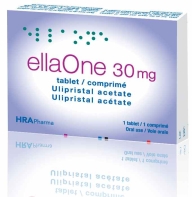NPR’s “Birth Control Without Copays Could Become Mandatory” gravely misleads its audience on the extent of pro-life Americans concerns about the health care reform law’s “preventive care” mandate including all FDA approved contraceptives.
Though noting one so-called “emergency contraceptive,” Plan B, can prevent implantation of a human embryo, NPR fails to discuss the other FDA approved so-called emergency contraceptive, ella, which can kill a human embryo even after implantation.
 ella is not, as the NPR article claims, different from the abortion pill mifepristone. Unlike Plan B, which is a progestin-based drug, ella is – just like mifepristone – a selective progesterone receptor modulator (SPRM). This means that though indicated as “contraception,” ella works the same way as mifepristone, not Plan B.[1] By blocking progesterone, a hormone necessary to build and maintain the uterine wall, ella and mifepristone can kill an already-implanted human embryo. Or, to use the NPR article’s phrase, ella can “disrupt a pregnancy that has already begun.”
ella is not, as the NPR article claims, different from the abortion pill mifepristone. Unlike Plan B, which is a progestin-based drug, ella is – just like mifepristone – a selective progesterone receptor modulator (SPRM). This means that though indicated as “contraception,” ella works the same way as mifepristone, not Plan B.[1] By blocking progesterone, a hormone necessary to build and maintain the uterine wall, ella and mifepristone can kill an already-implanted human embryo. Or, to use the NPR article’s phrase, ella can “disrupt a pregnancy that has already begun.”
When the FDA approved ella, it did not make any assurance that it would not disrupt a pregnancy. In fact, it said that ella may “affect” implantation.[2] The FDA chose different language when it approved Plan B, saying it may “prevent” implantation and explicitly stating that once an embryo implanted, Plan B would not terminate the pregnancy.[3]
Planned Parenthood, featured in NPR’s article, provides significant misinformation about ella. The FDA contraindicated ella “during an existing or suspected pregnancy.”[4] However, a document produced by Planned Parenthood Federation of America, available on its website, “Background on Ulipristal Acetate (ELLA),” disregards the FDA requirement. In answer to the question, “Who can use [ella]?,” the document states, “There are no contraindications (Glasier, 2010).”[5] And confusion of ella with Plan B – drugs that work in consequentially different ways – is prevalent throughout Planned Parenthood materials.
NPR quotes Planned Parenthood’s Deborah Nucatola as saying “there is no scientific evidence” that emergency contraception prevents implantation. However, the FDA and the drug manufacturers would disagree with Ms. Nucatola, and they require this mechanism of action be included in the drug labeling.[6]
Moreover, scientific studies demonstrate that ella not only prevents implantation, but can harm an “established” pregnancy. The FDA’s prescribing instructions for ella cite animal studies demonstrating high embryo-fetal loss.[7] In addition, the European Medicines Agency (EMEA), the EU equivalent of the FDA, indicated that ella “is embryotoxic at low doses, when given to rats and rabbits.”[8]
Although the Institute of Medicine will soon release its recommendation that all FDA approved contraceptives be included by the Department of Health and Human Services (HHS) in regulations regarding “preventive care,” AUL continues to urge HHS against this inclusion. AUL reminds HHS that Senator Barbara Mikulski, sponsor of the amendment to include the “preventive care” mandate, stated that her amendment was about preventing diseases, not about ending pregnancies.[9] Further, AUL supports the rights of Americans with conscientious objections not to be forced to subsidize contraception and sterilization, as would be required by the IOM recommendation.
LifeNews.com Note: Anna Franzonello is a staff attorney for Americans United for Life, a national pro-life organization. She is a graduate of the University of Notre Dame School of Law.
[1] The mechanism of action of ulipristal in human ovarian and endometrial tissue is identical to that of its parent compound mifepristone.” Harrison & Mitroka, Defining Reality: The Potential Role of Pharmacists in Assessing the Impact of Progesterone Receptor Modulators and Misoprostol in Reproductive Health, 45 Annals Pharmacotherapy 115 (Jan. 2011).
[2] ella Labeling Information (Aug. 13, 2010), available at https://www.accessdata.fda.gov/drugsatfda_docs/label/2010/022474s000lbl.pdf (last visited July 19, 2011).
[3] Plan B Approved Labeling, available at https://www.accessdata.fda.gov/drugsatfda_docs/nda/2006/021045s011_Plan_B_PRNTLBL.pdf (last visited July 19, 2011).
[4] See ella Labeling Information supra note 2.
[5] Planned Parenthood Fed’n of Am., Inc., Background on Ulipristal Acetate (Ella) (2010). Planned Parenthood’s background paper on ella also cites a 1998 study for the proposition that “[e]mergency contraception prevents ovulation. It has no impact on pregnancies that are already underway.” Id. (citing Van Look & Stewart, Emergency Contraception, Contraceptive Technology 277 (17th ed. 1998)). However, to make this point, the study examined progestin-based drugs. In fact, the study also acknowledges that RU-486, and similar drugs, could be used as “emergency contraception.” There is no debate that RU-486 also causes abortions in “pregnancies that are already underway.”
[6] See ella Labeling Information supra note 2; see also Plan B Approved Labeling supra note 3.
[7] See ella Labeling Information supra note 2.
[8]European Medicines Agency, Evaluation of Medicines for Human Use: CHMP Assessment Report for Ellaone 16 (2009), available at https://www.ema.europa.eu/docs/en_GB/document_library/EPAR_-_Public_assessment_report/human/001027/WC500023673.pdf (last visited July 19, 2011).
[9] See Press Release, Senator Barbara Mikulski, Mikulski Puts Women First in Health Care Debate (November 30, 2009), available at https://mikulski.senate.gov/Newsroom/PressReleases/record.cfm?id=320304. “This amendment is strictly concerned with ensuring that women get the kind of preventive screenings and treatments they may need to prevent diseases particular to women such as breast cancer and cervical cancer. There is neither legislative intent nor legislative language that would cover abortion under this amendment, nor would abortion coverage be mandated in any way by the Secretary of Health and Human Services.”







